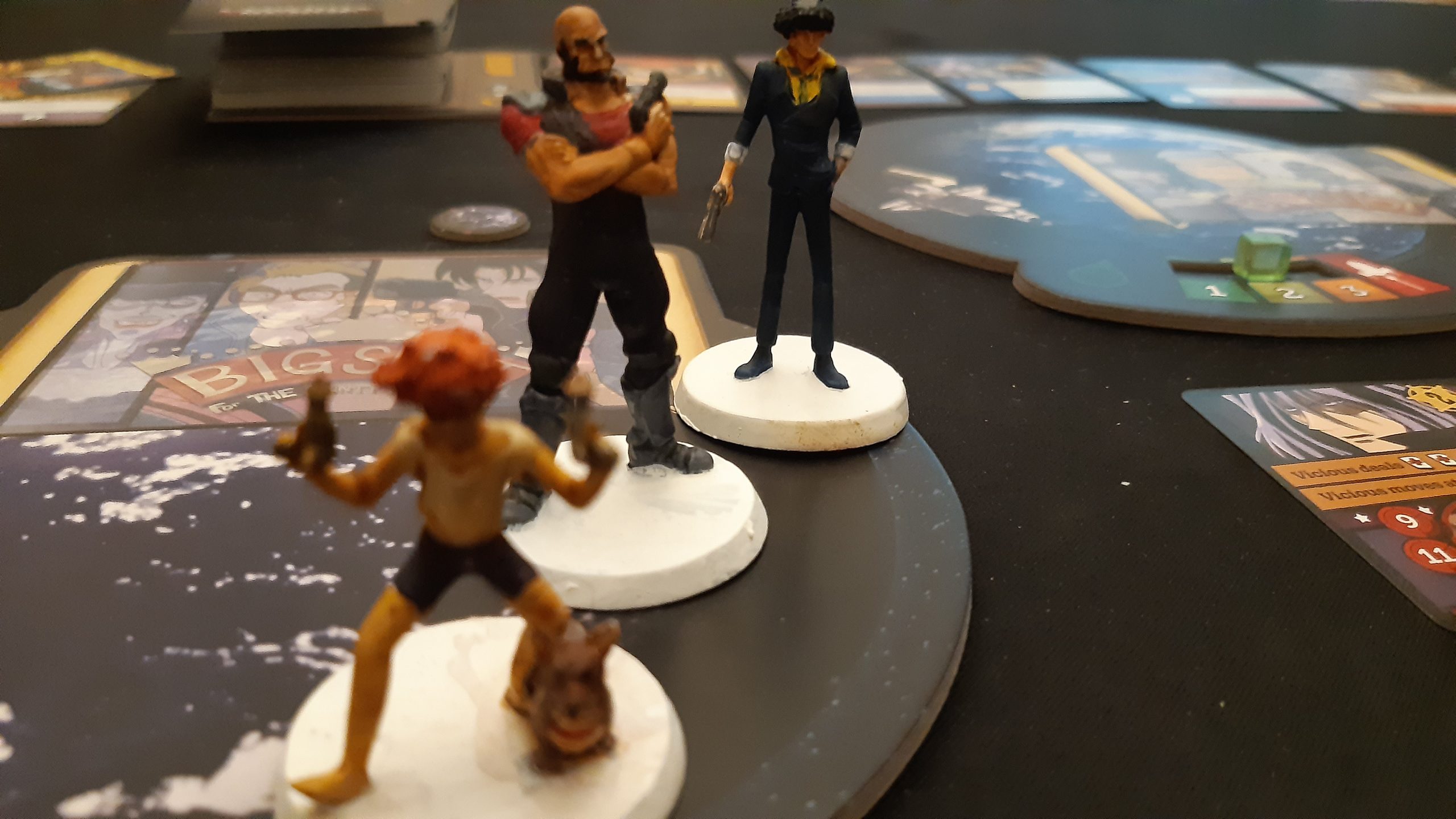From the Parallel Worlds Magazine archive.
Cowboy Bebop is one of those TV series which always makes it into lists of ‘If You’ve Never Seen Anime, Start Here’. It’s stylish, accessible and genuinely action-packed — a Japanese animated series for those who aren’t deeply into the subculture. Unsurprising, then, to see a board game break through using this series.
In fact, two have appeared in quick succession, different in style and from different publishers. So, to be clear: I’m talking about Cowboy Bebop: Space Serenade. This is a ‘deck-building’ game, very similar in design to the very popular Legendary Encounters series (Alien, Predator, X-Files, Buffy, Firefly et al). The crew of the Bebop compete to gain bounty points by weakening and capturing wanted criminals using violence or evidence, eventually leading to a climactic battle against the Big Bad, named Vicious.
For those who haven’t played a deck-builder before, every player has their own deck of cards which represent their skills. Each turn they play the cards in their hand, discard them, draw a new hand and continue until they run out of cards. At this point they shuffle their discards back into a deck and carry on. The starting deck contains very basic cards, made up of low money and weak attacks. The aim of the game is to use these basic cards to damage low-level enemies while also ‘buying’ better cards. The newly-purchased cards are generally added to the player’s discard pile, meaning that they will eventually find their way into the player’s deck, gradually improving the strength of future hands. Typically, these games also feature a way of removing low-quality cards from the deck, improving the potential strength of each draw even more.
Cowboy Bebop: Space Serenade adds a third and fourth currency to the genre standards of money and damage, in the form of fuel and evidence. Whilst violent encounters are a cheap way to gather points, they cause deck-diluting injury cards to be added to the player’s pile. Evidence, however, is more costly to gain and deploy, but generates no penalties.
Fuel is used to drive a spatial element not often found in deck-building games. Cowboy Bebop’s fugitives appear in three locations: Earth, Ganymede and Mars. Each player must spend fuel to move their character between locations to try to capture these fugitives. Fuel can also be spent to activate unique player powers, wonderfully themed around the characters from the series. Faye can trade fuel for spending power, Spike makes his own luck by drawing additional cards, Jet can remove injury cards and Edward is able to generate additional evidence points.
There is a wonderfully unsporting element among the competitive crew.
It’s the location element which really differentiates Cowboy Bebop: Space Serenade from many other deck-building games. Each player is competing to earn the highest bounties, so getting to each fugitive is a race. However, it is possible to use card abilities to move each other’s characters, so there is a wonderfully unsporting element among the competitive crew. Also, if another character is in your location, you can use one of their abilities. Therefore chasing the same bounty as another player makes your basic ability available to them, and vice-versa. Unplayed characters also remain present in every game, so they can be used as NPCs providing additional powers.
For me, the thing which Cowboy Bebop: Space Serenade absolutely nails is the semi-cooperative nature of the design. Very few games manage to create a common goal while at the same time attempting to win individually. In this game, if the final boss baddie isn’t beaten with a set number of turns, everybody loses. Fighting Vicious is a fairly stiff challenge and once you’ve played Cowboy Bebop: Space Serenade more than once, you’ll appreciate that you need to build a strong deck specifically designed to take him on. So, despite your fierce competition with other players, you will definitely need to work together a little to make sure his defeat is possible.
There’s a genuine love for the source material in the design of this game, with stills from the series reproduced in high quality on the cards and boards. The game comes with five wonderfully detailed miniatures, used to denote the locations of the characters. For those who prefer cardboard standees, these are also an option in the box; although the quality of the ‘stands’ is very poor, so you may find yourself raiding other games for plastic bases. But generally (apart from those bases) the component quality is exceptionally high.
For really hardcore deck-builder fans, the card play is probably at the lighter end of the scale. You won’t be creating super-powered combos as is possible in, say, Star Realms. However, Cowboy Bebop: Space Serenade is solid, highly accessible and provides a lot of scope to craft a deck the way you want it to be. The card abilities are varied and interesting and it definitely leans towards planning to build certain kinds of synergies each game, depending on what comes out in the draw of the card ‘store’. I taught this game to a player completely inexperienced with deck-builders and found it to be an excellent entry-level design. It also has a built-in solo mode which offers a pretty stiff challenge, so there’s lots of ways to enjoy it.
If you love Cowboy Bebop and enjoy card games, then I’d say Space Serenade is a must buy. It fits gameplay to the theme and tone of the series so perfectly, plays fairly quickly (under an hour for practised players) and is a tight and satisfying competition. If you just love the series and haven’t tried this style of game before, then I also recommend it. It’s simple to learn and a great introduction to deck-building games.



